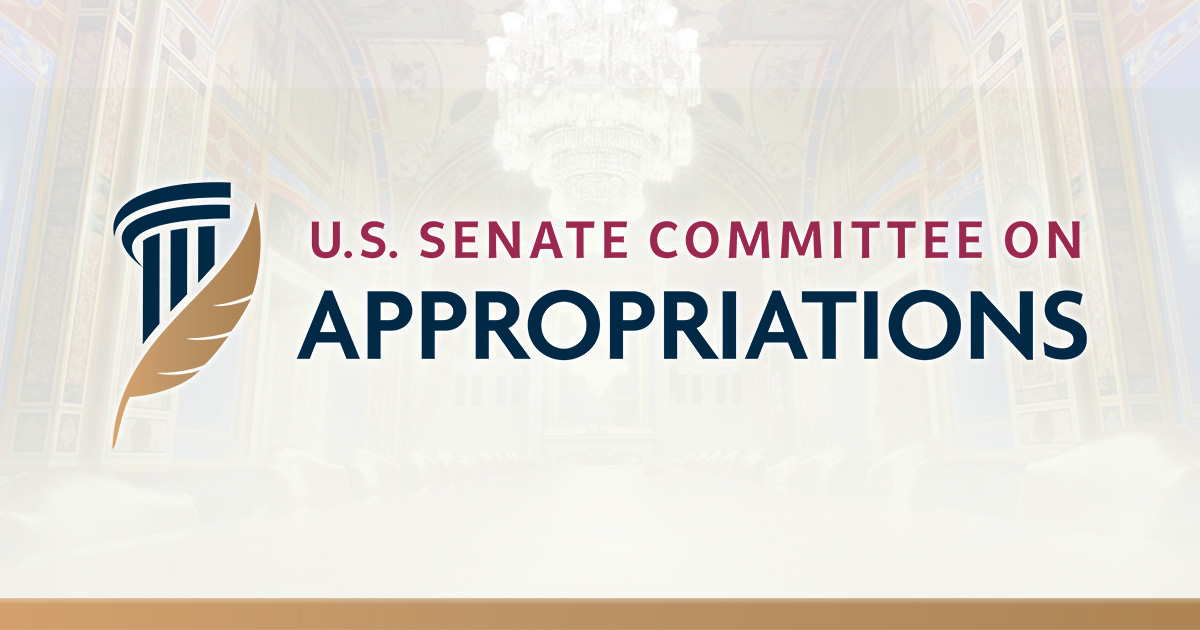BILL SUMMARY: Transportation, Housing and Urban Development, and Related Agencies Fiscal Year 2024 Appropriations Bill | United States Senate Committee on Appropriations
Majority News Release | Majority News Releases | News | United ... United States Senate Committee on Appropriations


Transportation, Housing and Urban Development, and Related Agencies Fiscal Year 2024 Appropriations Bill
July 20, 2023

The Transportation, Housing and Urban Development, and Related Agencies fiscal year 2024 appropriations bill provides $98.931 billion in total discretionary funding.
“Our bill directly addresses America’s housing crisis by protecting affordable housing and homeless assistance programs that will help nearly 10 million people,” said Senator Brian Schatz (D-HI), Chair of the Senate Appropriations Subcommittee on Transportation, Housing and Urban Development, and Related Agencies. “It also includes record level of investment in Native housing, and maintains funding to improve public transit, airports, railways, and roads across the country.”
“It’s critical we work to make sure people across our country can keep a roof over their head, aren’t left out in the streets, and can get to where they need to be safely and efficiently—and that’s what this bill helps do,” said Senator Patty Murray (D-WA), Chair of the Senate Appropriations Committee. “This is a strong bipartisan bill that makes critical investments to address the shortage of air traffic controllers and reduce flight delays, improve rail safety after recent, deeply concerning derailments, and continue investing in the infrastructure that helps Americans get to where they need to be. This bill also takes some critical steps to address homelessness in communities across America and increase the supply of housing to lower costs for families.”
Key Points & Highlights – Transportation
Department of Transportation:
- The bill provides $28.433 billion in funding for the Department of Transportation—which includes significant new resources to ensure the Federal Aviation Administration (FAA) is able to maintain the safest, most efficient, and most complex air traffic control system in the world, the safety of our rail network, and capital investments to improve the state of good repair for our transit systems.
RAISE Grants:
- The bill maintains critical funding for the RAISE Grant program established by Senator Murray to continue investing in transportation infrastructure projects that have a significant local or regional impact.
FAA Staffing and Modernization:
- The bill provides $20.279 billion for the FAA, an increase of $1.255 billion over fiscal year 2023. This includes:
- $12.741 billion for FAA operations, which will allow the FAA to continue its air traffic controller hiring surge by adding 1,800 new controllers, improve critical IT and telecommunications legacy systems, and accelerate the deployment of new entrants into the national airspace.
- A historic $3.429 billion for FAA facilities and equipment which will accelerate NextGen modernization.
- $3.852 billion for Airport Improvement Program (AIP) grants, including $502 million for supplemental AIP grants that can help reduce emissions at airports and build resiliency at airports confronting climate change and natural disasters.
Highways and Bridges:
- The bill provides $60.096 billion for Federal-aid Highways, consistent with the IIJA-authorized level of spending from the Highway Trust Fund, with an additional $2.047 billion for Highway Infrastructure Programs.
Rail Safety:
- A total of $3.4 billion is provided for the Federal Railroad Administration (FRA), including $2.45 billion for Amtrak to sustain operations and safely transport passengers.
Transit Infrastructure:
- The bill provides $16.865 billion for the Federal Transit Administration, including $2.45 billion for Capital Investment Grants, to continue investing in America’s transit infrastructure.
Maritime Administration:
- The bill provides $1.2 billion for the Maritime Administration, including funding for the United States Merchant Marine Academy, State Maritime Academies, and port infrastructure development.
Expands Access to Transportation Infrastructure for Tribes:
- The bill includes flexibilities in the federal share for certain transit projects and provides $25 million to supplement the Rural and Tribal Infrastructure Advancement Pilot Program to improve Tribal access to transportation infrastructure programs.
Key Points & Highlights – Housing and Urban Development
Department of Housing and Urban Development (HUD):
- The bill provides $70.06 billion in funding for HUD to maintain all existing rental assistance while increasing efforts to reduce homelessness, connect people to housing and health care, and remove barriers to housing opportunities and development.
Reduces Homelessness and Improves Connections to Health Care:
- The bill provides $3.9 billion for Homeless Assistance Grants, a $275 million increase above the fiscal year 2023 enacted level. This includes funding for permanent supportive housing and capacity-building grants to connect individuals experiencing homelessness to housing-related services and behavioral healthcare.
Increases the Supply of Affordable Housing:
- The bill includes $1.5 billion to sustain funding for the HOME Investment Partnership Program, $100 million for the “Yes In My Back Yard” grant program, and $4.3 billion for the Community Development Block Grant formula program and Economic Development Initiatives to address affordable housing needs.
Expands Access to Housing Assistance for Tribes:
- The bill increases funding for the Native American Housing Block Grant program and improves Tribal participation in the Homeless Assistance Grants program to address housing needs in Indian country.
Preserves and Strengthens Investments in Rental Assistance Programs:
- The bill maintains support for HUD rental assistance programs, including tenant-based Section 8 vouchers and project-based rental assistance.
Increases Alignment and Flexibilities for Affordable Housing Programs:
- The bill supports efforts to improve inspection standards, allows housing assistance payments for leasing-related expenses, and streamlines the award process for vouchers serving youth aging out of foster care.
SDGs, Targets, and Indicators Identified in the Article
SDGs
- SDG 1: No Poverty
- SDG 3: Good Health and Well-being
- SDG 7: Affordable and Clean Energy
- SDG 9: Industry, Innovation, and Infrastructure
- SDG 11: Sustainable Cities and Communities
- SDG 13: Climate Action
- SDG 17: Partnerships for the Goals
Targets
- Target 1.1: By 2030, eradicate extreme poverty for all people everywhere.
- Target 3.8: Achieve universal health coverage, including financial risk protection, access to quality essential health-care services, and access to safe, effective, quality, and affordable essential medicines and vaccines for all.
- Target 7.2: By 2030, increase substantially the share of renewable energy in the global energy mix.
- Target 9.1: Develop quality, reliable, sustainable, and resilient infrastructure, including regional and transborder infrastructure, to support economic development and human well-being, with a focus on affordable and equitable access for all.
- Target 11.1: By 2030, ensure access for all to adequate, safe, and affordable housing and basic services and upgrade slums.
- Target 13.2: Integrate climate change measures into national policies, strategies, and planning.
- Target 17.16: Enhance the global partnership for sustainable development, complemented by multi-stakeholder partnerships that mobilize and share knowledge, expertise, technology, and financial resources.
Indicators
- Indicator 1.1.1: Proportion of population below the international poverty line, by sex, age, employment status, and geographical location.
- Indicator 3.8.1: Coverage of essential health services (defined as the average coverage of essential services based on tracer interventions that include reproductive, maternal, newborn and child health, infectious diseases, non-communicable diseases, and service capacity and access).
- Indicator 7.2.1: Renewable energy share in the total final energy consumption.
- Indicator 9.1.1: Proportion of the rural population who live within 2 km of an all-season road.
- Indicator 11.1.1: Proportion of urban population living in slums, informal settlements, or inadequate housing.
- Indicator 13.2.1: Number of countries that have communicated the establishment or operationalization of an integrated policy/strategy/plan which increases their ability to adapt to the adverse impacts of climate change and foster climate resilience and low greenhouse gas emissions development in a manner that does not threaten food production.
- Indicator 17.16.1: Number of countries reporting progress in multi-stakeholder development effectiveness monitoring frameworks that support the achievement of the sustainable development goals.
Analysis
1. Which SDGs are addressed or connected to the issues highlighted in the article?
The SDGs addressed or connected to the issues highlighted in the article are:
- SDG 1: No Poverty
- SDG 3: Good Health and Well-being
- SDG 7: Affordable and Clean Energy
- SDG 9: Industry, Innovation, and Infrastructure
- SDG 11: Sustainable Cities and Communities
- SDG 13: Climate Action
- SDG 17: Partnerships for the Goals
2. What specific targets under those SDGs can be identified based on the article’s content?
Based on the article’s content, the specific targets under the identified SDGs are:
- Target 1.1: By 2030, eradicate extreme poverty for all people everywhere.
- Target 3.8: Achieve universal health coverage, including financial risk protection, access to quality essential health-care services, and access to safe, effective, quality, and affordable essential medicines and vaccines for all.
- Target 7.2: By 2030, increase substantially the share of renewable energy in the global energy mix.
- Target 9.1: Develop quality, reliable, sustainable, and resilient infrastructure, including regional and transborder infrastructure, to support economic development and human well-being, with a focus on affordable and equitable access for all.
- Target 11.1: By 2030, ensure access for all to adequate, safe, and affordable housing and basic services and upgrade slums.
- Target 13.2: Integrate climate change measures into national policies, strategies, and planning.
- Target 17.16: Enhance the global partnership for sustainable development, complemented by multi-stakeholder partnerships that mobilize and share knowledge, expertise, technology, and financial resources.
3. Are there any indicators mentioned or implied in the article that can be used to measure progress towards the identified targets?
Yes, there are indicators mentioned or implied in the article that can be used to measure progress towards the identified targets. These indicators are:
- Indicator 1.1.1: Proportion of population below the international poverty line, by sex, age, employment status, and geographical location.
- Indicator 3.8.1: Coverage of essential health services (defined as the average coverage of essential services based on tracer interventions that include reproductive, maternal, newborn and child health, infectious diseases, non-communicable diseases, and service capacity and access).
- Indicator 7.2.1: Renewable energy share in the total final energy consumption.
- Indicator 9.1.1: Proportion of the rural population who live within 2 km of an all-season road.
- Indicator 11.1.1: Proportion of urban population living in slums, informal settlements, or inadequate housing.
- Indicator 13.2.1: Number of countries that have communicated the establishment or operationalization of an integrated policy/strategy/plan which increases their ability to adapt to the adverse impacts of climate change and foster climate resilience and low greenhouse gas emissions development in a manner that does not threaten food production.
<
Behold! This splendid article springs forth from the wellspring of knowledge, shaped by a wondrous proprietary AI technology that delved into a vast ocean of data, illuminating the path towards the Sustainable Development Goals. Remember that all rights are reserved by SDG Investors LLC, empowering us to champion progress together.
Source: appropriations.senate.gov

Join us, as fellow seekers of change, on a transformative journey at https://sdgtalks.ai/welcome, where you can become a member and actively contribute to shaping a brighter future.







